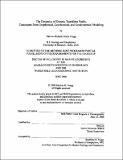The dynamics of oceanic transform faults : constraints from geophysical, geochemical, and geodynamical modeling
Author(s)
Gregg, Patricia Michelle Marie
DownloadFull printable version (42.31Mb)
Other Contributors
Woods Hole Oceanographic Institution.
Advisor
Jain Lin.
Terms of use
Metadata
Show full item recordAbstract
Segmentation and crustal accretion at oceanic transform fault systems are investigated through a combination of geophysical data analysis and geodynamical and geochemical modeling. Chapter 1 examines the effect of fault segmentation on the maximum predicted earthquake magnitude of an oceanic transform fault system. Results of thermal modeling suggest that fault segmentation by intra- transform spreading centers (ITSC) drastically reduces the available brittle area of a transform fault and thus limits the available earthquake rupture area. Coulomb stress models suggest that long ITSCs will prohibit static stress interaction between segments of a transform system and further limit the maximum possible magnitude of a given transform fault earthquake. In Chapter 2, gravity anomalies from a global set of oceanic transform fault systems are investigated. Surprisingly, negative residual mantle Bouguer gravity anomalies are found within fast-slipping transform fault domains. These gravity observations suggest a mass deficit within fast-slipping transform faults, which may result from porosity variations, mantle serpentinization, and/or crustal thickness variations. Two-dimensional forward modeling and the correlation of the negative gravity anomalies to bathymetric highs indicate crustal thickness excesses in these locations. Finally, in Chapter 3, mantle thermal and melting models for a visco-plastic rheology are developed to investigate the process of mantle melting and crustal accretion at ITSCs within segmented transform faults, and are applied to the Siqueiros transform fault system. Models in which melt migrates into the transform fault domain from a large region of the mantle best explain the gravity-derived crustal thickness variations observed at the Siqueiros transform. Furthermore, a mantle potential temperature of 1350⁰C and fractional crystallization at depths of 9 - 15.5 km best explain the major element composition variation observed at the Siqueiros transform.
Description
Thesis (Ph. D.)--Joint Program in Oceanography (Massachusetts Institute of Technology, Dept. of Earth, Atmospheric, and Planetary Sciences; and the Woods Hole Oceanographic Institution), 2008. Includes bibliographical references.
Date issued
2008Department
Joint Program in Oceanography; Woods Hole Oceanographic Institution; Massachusetts Institute of Technology. Department of Earth, Atmospheric, and Planetary SciencesPublisher
Massachusetts Institute of Technology
Keywords
Joint Program in Oceanography., Earth, Atmospheric, and Planetary Sciences., Woods Hole Oceanographic Institution.